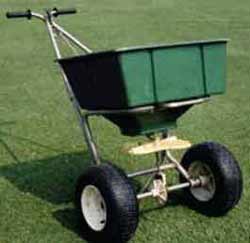Greening Your Grass the Eco Way
Air Date: Week of June 23, 2006

Eco-friendly lawncare requires delicate balance. (Photo courtesy of: Soil & Crop Sciences Department, Texas A&M University)
Living on Earth's Steve Curwood speaks with Urvashi Rangan - editor of greenerchoices.org, a service of consumer reports - about earth-friendly lawn care, pesticides, and natural ways to keep pests off the backyard.
Transcript
CURWOOD: It’s estimated Americans spend more than 30 billion dollars a year caring for their lawns. Now that’s a lot of green, much of it spent on things you don’t really need to grow a great lawn. Well, so says Urvashi Rangan. She’s editor of greener choices.org – a service of Consumer Reports – and she says you can grow green grass in a green way and save money. Her first tip: lay off the lawn chemicals.
RANGAN: The number one most environmentally-damaging thing we do through lawn care is the amount of pesticides we put on to lawns. It’s estimated that we use 100 million pounds of pesticides every year in home gardens, and much of that is really on lawns.
And one interesting statistic we came across is the National Academy of Sciences estimated that 50 percent of a person’s lifetime pesticide exposure actually occurred in their first five years of life. And what that says to us is kids who are out there playing on the lawn, pets who are out there playing and then putting hands or paws into mouths, can really up the amount of exposure you have to pesticides.
CURWOOD: But the chemical companies Urvashi say they’re safe.

Eco-friendly lawncare requires delicate balance. (Photo courtesy of: Soil & Crop Sciences Department, Texas A&M University)
You can do some homework yourself by cross-checking the active ingredients in those products with the environmental protection’s cancer list. So, for example, carbaryl, which is a common active ingredient in pesticides, is considered to be a likely human carcinogen. And there’s more than a dozen that are considered by the Environmental Protection Agency to have some probable or possible carcinogenicity.
CURWOOD: This stuff works, though. I mean, people who use these things, their lawns are like perfect, there’s no crabgrass, it’s just absolutely this lush green appearance.
RANGAN: It is true, and, unfortunately, just because your lawn looks green it doesn’t mean it’s clean. And there are other ways, actually, of maintaining a healthy lawn that we can do in a much more sustainable way that isn’t going to be potentially harmful to those who actually play on the lawn.
CURWOOD: So what are the effective natural non-toxic pesticide alternatives?
RANGAN: Well there’s a couple of things people can do. I mean, the first thing to remember is that a healthy lawn is your best defense. So if you keep that lawn healthy, you’re watering it properly, and you’re keeping it fertilized, that’s your number one defense. The second thing you can do is also use some, what we call natural, or biological, controls for your lawn. People may be surprised to know that cornmeal gluten, for example, can be used for weed control like crabgrass in lawns. Ladybugs can be used to control pests. And then there’s other controls, too, like botanical oils, citrus oils, concentrated pepper or garlic juices that can be diluted and sprayed on lawns. All of those have been shown to be effective against pests.
CURWOOD: So I can get rid of those dandelions if I just pour some cornmeal on it?
RANGAN: (Laughs) You know, a lot of it too when we talk about organic techniques is getting out there and picking your dandelions. So physical controls we talk about a lot, too, can also be effective. You don’t always have to hose down your lawn in chemical to get the sort of weed-controlled green lawn.
CURWOOD: Now, come on, wouldn’t the most natural way to take care of a lawn be just, you know, to get some sheep or something? You get fertilizer, you get things cut, and the lawnmowers keep reproducing so you don’t have to go out and buy another one.
RANGAN: (Laughs) I think they have plastic grass now that you can just lay out and, you know, you never need to mow it, you don’t need to do much. Is that more sustainable?
CURWOOD: Urvashi Rangan is editor of greener choices.org, a service of Consumer Reports. Thanks Urvashi.
RANGAN: Thank you, Steve.
Links
Living on Earth wants to hear from you!
Living on Earth
62 Calef Highway, Suite 212
Lee, NH 03861
Telephone: 617-287-4121
E-mail: comments@loe.org
Newsletter [Click here]
Donate to Living on Earth!
Living on Earth is an independent media program and relies entirely on contributions from listeners and institutions supporting public service. Please donate now to preserve an independent environmental voice.
NewsletterLiving on Earth offers a weekly delivery of the show's rundown to your mailbox. Sign up for our newsletter today!
 Sailors For The Sea: Be the change you want to sea.
Sailors For The Sea: Be the change you want to sea.
 The Grantham Foundation for the Protection of the Environment: Committed to protecting and improving the health of the global environment.
The Grantham Foundation for the Protection of the Environment: Committed to protecting and improving the health of the global environment.
 Contribute to Living on Earth and receive, as our gift to you, an archival print of one of Mark Seth Lender's extraordinary wildlife photographs. Follow the link to see Mark's current collection of photographs.
Contribute to Living on Earth and receive, as our gift to you, an archival print of one of Mark Seth Lender's extraordinary wildlife photographs. Follow the link to see Mark's current collection of photographs.
 Buy a signed copy of Mark Seth Lender's book Smeagull the Seagull & support Living on Earth
Buy a signed copy of Mark Seth Lender's book Smeagull the Seagull & support Living on Earth

